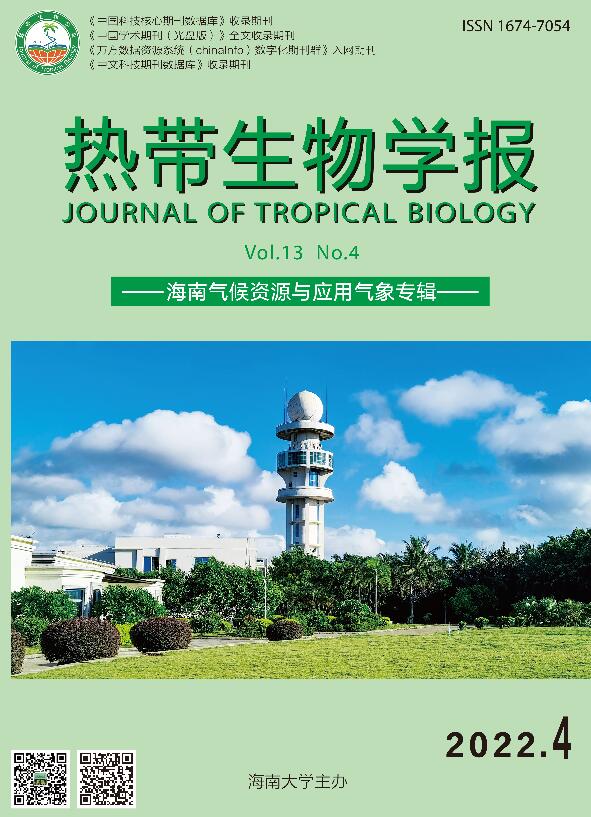-
天然橡胶是重要的战略物资和稀缺资源。目前,以天然橡胶为原料的工业产品多达8万多种,由于其独特的性能,使其成为飞机轮胎、液态天然胶乳等领域不可或缺的重要原料。橡胶树(Hevea brasiliensis )是天然橡胶最主要的原料供应植物[1]。为保障我国天然橡胶有效供给,国家制定了一系列关于天然橡胶产业发展的指导意见,2017年确立在云南、海南、广东等地分别建立60万hm2、56万hm2和4万hm2的天然橡胶生产保护区[2]。由于我国橡胶树种植区纬度偏北和海拔偏高,导致橡胶树在生长过程中易遭受风灾、寒害、旱灾等多种气象灾害的影响。自然资源条件在一定程度上限制了我国天然橡胶产业的发展,适宜种植橡胶的区域十分有限,要增加天然橡胶的供给必须提高橡胶树单位面积产量[3]。造成橡胶树产胶量波动的因素较多,其中,乳胶的合成和顺利排出对产量形成至关重要[4]。由于橡胶树是典型的热带作物,其生长和产胶对气象条件变化相对敏感,我国是橡胶树种植的非传统区域,气候因子成为了影响橡胶树产量的重要因素之一[5-6]。国内外许多学者从不同角度对橡胶树产胶量的影响因子开展了深入研究。温度是我国橡胶树种植的主要限制因子直接影响橡胶树的生长、发育和产胶,橡胶树的产胶量随热量条件的增加而增加[7],橡胶树干物质积累会因温度的升高而增加,当温度超出一定范围,橡胶树光合速率小于橡胶树呼吸速率速率,橡胶树干物质积累随温度升高而减少[8-10]。橡胶树胶乳的合成离不开大量的水分, 水分的多少将直接影响橡胶树产量的高低,在一定温度条件下,橡胶树产胶量会随着相对湿度增加而增加[11];日照时数也会影响橡胶树的糖代谢和养分积累,合适的日照时数将有益于橡胶树生长和产胶。橡胶树适宜微风环境,风偏大或无风情况下均不利于橡胶树的光合和蒸腾作用,直接影响橡胶树体内物质合成[7]。方天雄[12]开展了气候因子对云南河口地区橡胶树产量的影响研究;何康等[13]指出,温度、光照时长、水分、风速大小、土壤养分、海拔高程和地形对橡胶树产量都有影响;杨铨[14]根据西双版纳5年的橡胶产量数据,分析了温度、降水、日照与橡胶树产量的关系;徐其兴[9]分析了橡胶树产胶量与温度和热量的关系;橡胶树产胶量与降水量的关系具有一定的不确定性,有研究显示,降雨量增加能够提高产胶量[15-16]。邓军等[7]等分析了橡胶树高产高效栽培的影响因素;李国尧等[6]从气象因子、割胶技术、土壤成分、病虫害、橡胶树品种和胶园管理水平等方面综合分析了影响橡胶树产胶量的因素;张源源等[17]分析了气象因子对不同产胶特性橡胶树产量的影响;NGUYEN等[18]分析了平均温度、平均最高温度、平均最低温度与越南橡胶树产量的关系;张慧君等[19]的研究表明,日照时数和气温是影响海南橡胶树产量的主要气象因子。
虽然我国在云南、海南、广东等地开展橡胶树种植的环境较好,但橡胶树仍面临不同程度的气象灾害(寒害、风害和旱害),气象灾害每年都会导致橡胶遭受一定的损失[20-22]。笔者从橡胶种植分布、橡胶树种植区北界、气象灾害的影响、橡胶种植气候适宜性等方面简要总结了气象条件对橡胶树种植的影响,旨在为下一步开展高质量橡胶气象服务提供参考。
-
自20世纪80年代开始,我国对橡胶树种植气候适宜区展开了大量的调查研究,对橡胶树种植北界进行了深入探讨[27-29]。刘少军等[30]基于近30年全国气象数据及我国橡胶树种植资料,提出并验证了80%气候保证率下中国橡胶树稳产高产的种植北界,通过与已有研究[27-29]和中国橡胶植胶现状图对比,80%气候保证率确定的中国橡胶树种植北界范围更符合中国橡胶树种植的实情。根据气候因子划分的中国橡胶树种植北界实质上是一个橡胶树稳产高产的种植北界,北界范围覆盖云南、广西、广东、福建。其中,勐海—澜沧—思茅—江城一带为云南的橡胶种植北界,龙州—大新—抚绥—钦州—浦北—北流一带为广西的种植北界,粤西南部的信宜—阳春—阳江一带及粤东部的潮阳—揭阳—丰顺—饶平一带为广东的种植北界,诏安—云霄—平和—龙海一带为福建的种植北界。文献[30]分别给出了气候保证率分别为50%、60%、70%和80%的中国橡胶树种植北界。其中,当气候保证率为50%时,中国橡胶树种植的北界涵盖范围最大,气候保证率为80%时,涵盖范围最小,且随着气候保证率的增加,橡胶树种植范围呈现由北向南缩小趋势。除云南和福建的部分区域外,气候保证率为50%、60%和70%时,划定的橡胶树种植北界包含范围均较现有研究确定的北界范围广阔[5-7,28-29],采用80%气候保证率下确定的橡胶树种植北界更符合橡胶生产实际,安全性更高。随着未来气候变化,中国橡胶种植区的北界也必将发生一定的变化。
-
台风和低温灾害是影响中国橡胶树存活及产胶量的主要气象灾害[20]。台风过程中,随着风速的增加,橡胶林的灾损程度随之增大[31]。台风轻则可以使橡胶树树冠受损,重则可以使橡胶树树干发生断、倒,当橡胶树受到台风影响后,其生理特征要比受灾年前同期的状况差[32]。根据台风路数据集提取了中国橡胶树种植区内台风路径和风速相关信息,从致灾体本身出发,结合橡胶树风害的致灾特点,建立了橡胶树台风灾害危险性评估模型,分析了中国橡胶树台风灾害危险性等级分布,其中,广东的徐闻、电白、朝阳,海南的三亚、陵水、万宁、文昌等地为台风灾害高危险区;福建的诏安,广东的阳江、茂名,海南岛的南部等地为台风灾害中危险区;福建的云霄−长泰,广东的信宜、廉江一带,海南岛的中、西部,广西的玉林、北海、陆川等地为台风灾害较低危险区;云南境内为台风灾害低危险区 [33]。
-
橡胶树寒害具有累积性的特征,其受害程度有时与持续时间短的低温之极值相关性较小,而与低温的持续时间关系紧密,持续时间越长,低温频率越大,寒害越严重。低温主要由冷却降温所造成,在冷却降温过程中,有平流和辐射两种主要形式。中国橡胶树易受寒害影响的区域主要分布在云南的盈江、陇川、屏边、马关等地;受寒害影响较小区域分布在海南、云南的景洪、勐腊等地[34]。根据1961—2010年气候资料分析表明,整个中国橡胶种植区出现轻度、中度、重度、特重寒害的平均频率分别为3.5%、28.24%、14.93%、15.93% 。从年代变化趋势来看,仅橡胶树轻度寒害的频率呈现增加趋势,而中度、重度、特重寒害频率总体均呈现减少趋势。而在中国的云南、海南两大橡胶树种植优势区出现寒害的频率均较低。如在云南橡胶主产区(景洪、勐腊、澜沧等地)出现轻度、中度、重度、特重寒害的平均频率分别为5.0%、31.0%、1.33%、0。海南岛橡胶产区出现轻度、中度、重度、特重寒害的平均频率分别为0.67%、5.08%、1.42%、0。橡胶综合寒害各年代出现的频率分布见表1[35]。
研究区域 年份 轻度寒害频率 中度寒害频率 重度寒害频率 特重寒害频率 中国橡胶种植区(5省种植范围内) 1961—1970 3.20 32.076 15.28 20.57 1971—1980 3.77 33.02 16.98 16.23 1981—1990 0.37 25.47 14.72 21.13 1991—2000 5.66 28.68 15.66 13.96 2001—2010 4.48 21.93 12.03 7.78 平 均 3.50 28.24 14.93 15.93 云南西橡胶产区(景洪、勐腊、澜沧等地) 1961—1970 3.33 40.00 3.33 0 1971—1980 3.33 30.00 3.33 0 1981—1990 0 30.00 0 0 1991—2000 10.00 30.00 0 0 2001—2010 8.33 25.00 0 0 平 均 5.00 31.00 1.33 0 海南橡胶主产区 1961—1970 1.67 8.33 0 0 1971—1980 1.67 8.33 1.67 0 1981—1990 0 1.66 1.67 0 1991—2000 0 5.00 1.67 0 2001—2010 0 2.08 2.08 0 平均 0.67 5.08 1.42 0 -
橡胶的气候适宜性不仅与其生理特性有关,也受到各种气象灾害影响,因此综合分析橡胶树的种植概率、台风灾害风险和寒害风险,得到了中国区域的橡胶种植气候适宜性分区。(1)橡胶的高适宜种植区约5万km2,占整个研究区域的21%。分布范围包括海南岛西部的儋州、乐东,北部的澄迈、定安和南部的保亭;云南的景洪、勐腊;广西的防城;广东的徐闻、雷州、湛江、阳江;福建的诏安、云霄等地。此区域内气候条件相对较好,但部分靠近沿海区域易受台风影响,橡胶生产要考虑台风灾害的影响。(2)橡胶的中适宜区面积约9万km2,占研究区面积的36%。分布范围包括海南岛西部的东方、昌江,东部的琼海、万宁和中部的琼中;云南的旧过、瑞丽;广西的北海、合浦;广东西部的高州、信宜、廉江、茂名和东部的惠来、潮州;福建的漳浦、漳州等地。与橡胶种植气候高适宜区相比,此区域不断橡胶树寒害发生概率有所增加,而且部分区域受到台风影响的概率也有所增加,因此要增加橡胶树寒害、风害的防御工作。(3)橡胶的低适宜区面积约10万km2,占研究区面积的43%。分布范围包括云南南部的屏边、思茅和西部的永德、盈江等地;广西南部的浦北、玉林;广东东部的陆河、海丰和西部的阳春;福建南部的华安等地。该区域主要受寒害影响为主[34]。
全球气候变化也使中国橡胶树种植的气候适宜区发生了改变。通过统计中国1981—2010年站点气候数据和RCP4.5情景的气候预测数据,分别从1981—2010年、2041—2060年和2061—2080年3个时段阐述气候变化对中国橡胶种植气候适宜性的影响。结果显示:随着全球持续变暖,相比1981—2010年,未来(2041—2080年)中国适合种植橡胶的区域呈扩大的趋势,种植边界明显北移。其中,高气候适宜区和中气候适宜区面积均有显著增加趋势,低气候适宜区面积有减少趋势。地区间的气候适宜区面积变化较大,如云南的橡胶适合种植区面积呈下降趋势,景洪、猛腊地区的气候适宜性降低,而海南和广东区域的气候适宜性呈上升趋势,出现更多高适宜区,台湾的橡胶种植气候适宜区面积也有一定增长[36]。
-
全球橡胶单产较高的国家主要分布在非洲和东南亚地区,而中国由于受台风和低温等气象灾害的影响,产量相对较低,而且空间差异较大[37]。根据统计,2004—2005年海南台风灾害较重,农垦胶园的干胶单产降低369 kg·hm−2,单株产量降低0.5 kg[38]。部分管理好、灾害轻的胶园产量相对较高,如云南的胶园最高达到4 314 kg·hm−2,海南部分胶园也可以达到3 570 kg·hm−2,广东的单产相对较低,最高仅为1 500 kg·hm−2[37]。目前,天然橡胶的种植生产相比市场需求存在较大缺口,研究表明,提高橡胶单产可有效解决这一矛盾[3]。中国不同种植区域的橡胶产胶能力存在很大差别。通过2000—2015年的卫星遥感影像数据分析可知,云南的橡胶树产胶能力最大,海南其次,而广东最小[39]。气候资源丰富程度和气象灾害风险是影响橡胶树产胶能力的主要因素。综合分析,云南的单位产量最高,但云南受限于气候适宜性,适宜种植橡胶的区域难以大面积增加;海南的光、热、水等气候条件非常适宜橡胶生长,但风害极重,限制了产胶能力的提高;而广东的气候资源相对较差,风害和寒害又重于云南和海南,因此种植规模有限,产量也一直处于低位[15]。综上可以看出,各地区均存在不同的优势和劣势,需要有针对性地开展橡胶园科学管理,更新改造低产橡胶园,培育高产高抗性优良品种,保障高产植区面积稳定,才能大幅提高胶园生产能力[39]。
-
天然橡胶关乎国计民生,由于近几年来天然橡胶价格一直处于低位,导致胶农橡胶树种植的积极性不高,在一些地方出现了橡胶园弃割、弃管等现象。相比热带的东南亚和非洲地区,中国满足橡胶气候适宜性的地区较少,面对日益增长的国内外市场需求,开展相关技术研究,最大限度地提高橡胶树单位面积产量是保证天然橡胶产业持续、健康发展,促进胶农增收,化解天然橡胶生产保护工作困境的最有效途径之一。
(1)我国橡胶主产区常年受风害、寒害影响,降水时空分布不均,土地贫瘠,橡胶树要获得稳产和高产,首先要合理选择橡胶树栽培种植的气候高适宜区开展种植,保证橡胶具有较高单产,减少盲目种植投资。对于低适宜区已经种植橡胶树的区域,建议改种其他高附加值经济作物,提高土地的综合效益,带动农民就业增收、增强农业农村发展新动能。
(2)构建全球橡胶产量预报模型,精准预测橡胶产量的动态变化和市场需求变化,集合橡胶主产区技术力量形成优势互补,将我国建成全球天然橡胶生产、加工制造、销售集散中心,提高产品科技含量形成高附加值,增强全球市场竞争力,保障国家工业战略安全[40]。
(3)在全球气候变化背景下,台风、寒害、干旱等气象灾害风险将长期存在,气象灾害将严重影响中国橡胶种植区,需要加强橡胶树抗风、抗寒、抗旱等高产栽培技术的研究。同时,在整个橡胶产业布局优化中,需要保证在高气候适宜区内有一定面积的橡胶战略性种植,大力发展橡胶树的林下经济。强化橡胶生产气象服务保障工作,减少极端天气气候事件对橡胶生产的影响。
Influence of climate factors on rubber plantation in China
doi: 10.15886/j.cnki.rdswxb.2022.04.008
- Received Date: 2021-09-15
- Accepted Date: 2022-04-08
- Rev Recd Date: 2022-04-13
- Available Online: 2022-05-25
- Publish Date: 2022-07-26
-
Key words:
- rubber tree /
- meteorological disaster /
- climatic suitability /
- yield /
- impact
Abstract: It is very important to improve rubber yield by avoiding the impact of meteorological disasters effectively and making full use of the advantages of climate resources to tap the rubber production potential of rubber tree. The impacts of climate factors on the global distribution of rubber plantations and the northern boundary for rubber plantation in China, the impact of meteorological disasters (typhoon and cold injury) on rubber plantations in the rubber producing areas in China, the distribution of rubber planting areas with climatic suitability in China, and the differences and reasons of rubber production capacity in China were summarized and analyzed from the perspective of climatic factors, based on which some suggestions are put forward to ensure stable and high rubber yield of rubber plantations in China, such as reasonably choosing areas with climatic suitability for rubber planting, strengthening research and development on high yielding cultivation with resistance to typhoon, cold and drought, guaranteeing a given strategic rubber planting area with high climatic suitability in the layout of rubber plantation industry, promoting rubber-based farming in rubber plantations, and enhancing the meteorological service in rubber production to reduce the impact of extreme weather and climate events on rubber production.
| Citation: | LIU Shaojun, CAI Daxin, Tong Jinhe, LI Weiguang. Influence of climate factors on rubber plantation in China[J]. Journal of Tropical Biology, 2022, 13(4): 376-381. doi: 10.15886/j.cnki.rdswxb.2022.04.008 |






 DownLoad:
DownLoad: